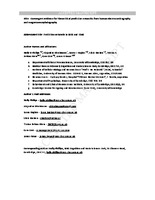Repositorio Digital
Convergent evidence for hierarchical prediction networks from human electrocorticography and magnetoencephalography
- DSpace Principal
- →
- Hospital El Cruce
- →
- Publicaciones
- →
- Artículos
- →
- Ver ítem
JavaScript is disabled for your browser. Some features of this site may not work without it.
Mostrar el registro sencillo del ítem
| dc.contributor.author | Phillips, Holly N. | |
| dc.contributor.author | Blenkmann, Alejandro | |
| dc.contributor.author | Hughes, Laura | |
| dc.contributor.author | Kochen, Silvia | |
| dc.contributor.author | Bekinschtein, Tristan | |
| dc.contributor.author | Can, Cam | |
| dc.contributor.author | Rowe, James | |
| dc.date.accessioned | 2016-05-17T15:51:02Z | |
| dc.date.available | 2016-05-17T15:51:02Z | |
| dc.date.issued | 2016 | |
| dc.identifier.issn | 0010-9452 | |
| dc.identifier.uri | http://repositorio.hospitalelcruce.org/xmlui/handle/123456789/379 | |
| dc.description | Fil: Kochen, S. Hospital de Alta Complejidad en Red El Cruce Dr. Néstor C. Kirchner. Centro Nacional de Alta Complejidad en Neurociencias y Neurocirugía. Florencio Varela, Argentina. | es_AR |
| dc.description.abstract | We propose that sensory inputs are processed in terms of optimised predictions and prediction error signals within hierarchical neurocognitive models. The combination of non-invasive brain imaging and generative network models has provided support for hierarchical frontotemporal interactions in oddball tasks, including recent identification of a temporal expectancy signal acting on prefrontal cortex. However, these studies are limited by the need to invert magnetoencephalographic or electroencephalographic sensor signals to localise activity from cortical ‘nodes’ in the network, or to infer neural responses from indirect measures such as the fMRI BOLD signal. To overcome this limitation, we examined frontotemporal interactions estimated from direct cortical recordings from two human participants with cortical electrode grids (electrocorticography). Their frontotemporal network dynamics were compared to those identified by magnetoencephalography in forty healthy adults. All participants performed the same auditory oddball task with standard tones interspersed with five deviant tone types. We normalised post-operative electrode locations to standardised anatomic space, to compare across modalities, and inverted the MEG to cortical sources using the estimated lead field from subject-specific head models. A mismatch negativity signal in frontal and temporal cortex was identified in all subjects. Generative models of the electrocorticographic and magnetoencephalographic data were separately compared using the free-energy estimate of the model evidence. Model comparison confirmed the same critical features of hierarchical frontotemporal networks in each patient as in the group-wise magnetoencephalography. These features included bilateral, feedforward and feedback frontotemporal modulated connectivity, in addition to an asymmetric expectancy driving input on left frontal cortex. The invasive electrocorticography provides an important step in construct validation of the use of neural generative models of magnetoencephalography, which in turn enables generalisation to larger populations. Together, they give convergent evidence for the hierarchical interactions in frontotemporal networks for expectation and processing of sensory inputs. | es_AR |
| dc.language.iso | es | es_AR |
| dc.subject | Electrocorticografía | es_AR |
| dc.subject | Magnetoencefalografía | es_AR |
| dc.subject | Técnicas de Diagnóstico Neurológico | es_AR |
| dc.subject | Cognición | es_AR |
| dc.title | Convergent evidence for hierarchical prediction networks from human electrocorticography and magnetoencephalography | es_AR |
| dc.type | Article | es_AR |
Ficheros en el ítem
Este ítem aparece en la(s) siguiente(s) colección(ones)
-
Artículos
Articles

